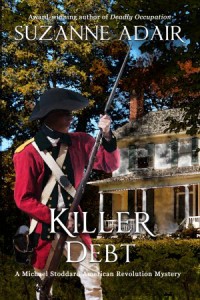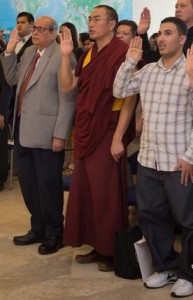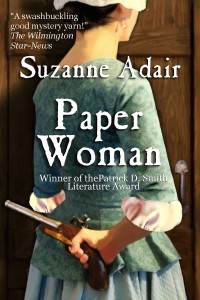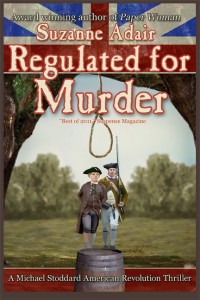From the Vault: A budget proposed in 2013 by the governor of the state of North Carolina called for closure of four historical sites to save money. (How much money would this really save? Read the end of the article.) Whenever something like this appears in the news, it spotlights people who didn’t learn history. Remember what George Santayana said? “Those who cannot remember the past are condemned to repeat it.” History has a lot to say about modern times. Historical mysteries, too, have a lot to say about our time, as I discuss in the following essay, originally published at PPWebcon in 2009.
*****
For many of us, history is a huge hurdle we negotiated in school, a dry gulch of treaty and battle dates regurgitated on tests. Although we’re given such admonitions as George Santayana’s “Those who cannot remember the past are condemned to repeat it,” few enjoy studying the lessons of history, let alone reading a mystery set in times past. Historical whodunits that are long on descriptions of clothing and food and short on plot and characterizations have given the entire sub-genre a bad reputation. It’s as if historical mysteries are the dorks on the dance floor of crime fiction, surrounded by sleekly twirling thrillers, sinuous suspense schemes, and cheetah-like cozies. Are historical mysteries really just for geeks? Or are their messages relevant to a wider readership?
All mystery fiction deals with righting wrongs. At the heart of those rights and wrongs is the duality of human nature. Socrates observed, “Bad men live that they may eat and drink, whereas good men eat and drink that they may live.” So it looks as though human nature has remained fairly consistent throughout recorded history. We tote the baggage of various dysfunctions with us through millennia while striving to balance “the Dark Side” with philanthropy, gratitude, love, compassion, and other characteristics that exemplify the best that humanity has to offer.
One reason we conveniently forget lessons from history is that significant events become shrouded in myth, even within our lifetimes. Farther back than our grandparents, we have little connection with the people who moved and shook the earth. Those of us in affluent countries have access to instant communications, antibiotics, fast food, and reliable transportation, whereas danger and scarcity often shaped the everyday decisions of our ancestors who lived on the same soil. Via school history textbooks, the courage these ancestors displayed filters down to us as the extraordinary fearlessness of comic book superheroes. Since you probably don’t know many fearless superheroes, you can easily dismiss people of the past and their vital stories.
But what if our ancestors’ courage was less about extraordinary, fearless superheroes and more about ordinary people who responded appropriately in the presence of their own fear? Let’s look at when you might have done so recently. Have you quit a job or started a home-based business? Left an abusive relationship? Run a daylong marathon? Such accomplishments require courage. Fear of failure plucks at us each time we move forward. Ordinary, non-superhero folks like you and me challenge ourselves every day. Somehow we find ways to respond appropriately, bypass the fear-snags, better ourselves, right wrongs. It’s human nature to do so.
Well-written historical mysteries transport us into a past teeming with the sort of prickly issues we deal with today as well as horrors we’d rather relegate to an earlier time — but we cannot do so because they haunt us still. In the course of fictional investigations, protagonists from the past tackle gritty matters like addiction, amputation, sexual predation, post-traumatic stress disorder, hate crimes, and human trafficking. Since there’s no Dr. Phil or even Dr. Freud to coach the characters of most eras through the psychology, we receive a window into how real people in history might have managed what was deviant. And somehow they must have done it. After all, we’re here today.
By transporting us into another time, authors of historical mysteries cleverly showcase the duality of human nature from a different angle. Historical mysteries challenge us to ponder issues anew, search ourselves for solutions buried beneath the layer of techno-babble that coats the twenty-first century, resolutions perhaps invisible behind the defenses we erect about our souls. We read of human beings plagued with faults but striving to right wrongs, just as we struggle today. Dull reading? Hardly.
If you believe all historical mysteries are set in England or North America, you haven’t read from the sub-genre lately, and you’re in for a treat. Detectives through the ages solve crimes in Egypt and the Middle East, the Byzantine Empire, Japan, Australia, Mexico, India, Tibet, Africa, Laos, and South America. Crime Thru Time is one of several web sites providing a timeline of historical mystery series. Pick out an intriguing “when” and “where” on the site. Then prepare yourself to escape into the past and have fun. While you’re connecting to history in ways your teachers could never have imagined, don’t be surprised if a mystery author sneaks in one of those lessons that we’re supposed to learn about good, evil, courage, and human nature.
**********
Did you like what you read? Learn about downloads, discounts, and special offers from Relevant History authors and Suzanne Adair. Subscribe to Suzanne’s free newsletter.
 I’m running a bit behind on updates; last week I was organizing all my 2017 tax information for my accountant. Since I last posted, Ben Steelman at the Wilmington Star-News posted a great article about Killer Debt (although he misnamed my detective as “Matthew” instead of “Michael,” and the house on the front cover is actually the Nash-Hooper House in Hillsborough, NC). Also, Christine Gentes reviewed Killer Debt on her blog.
I’m running a bit behind on updates; last week I was organizing all my 2017 tax information for my accountant. Since I last posted, Ben Steelman at the Wilmington Star-News posted a great article about Killer Debt (although he misnamed my detective as “Matthew” instead of “Michael,” and the house on the front cover is actually the Nash-Hooper House in Hillsborough, NC). Also, Christine Gentes reviewed Killer Debt on her blog.



